Nursing Ethics and Diabetes: A Case Study of Stephen's Care
VerifiedAdded on 2020/05/11
|9
|2180
|231
Case Study
AI Summary
This case study focuses on Mr. Stephen, a young man with a learning disability and type 2 diabetes, who experiences distress during insulin administration, leading to treatment discontinuation. The paper analyzes the ethical framework of nursing, particularly the four-quadrant approach, to address Stephen's treatment plan. It explores the altered pathophysiology of diabetes and emphasizes the importance of patient preferences, quality of life, and contextual features. The study highlights the need for nurses to address both the physical and cognitive disabilities of the patient by building a therapeutic relationship and providing care tailored to the individual's needs, including dietary changes, exercise plans, and psychological support. The case study underscores the significance of ethical codes, collaborative care, and evidence-based practices in managing diabetes in patients with learning disabilities, aiming to improve their quality of life and adherence to treatment. The document is contributed by a student to be published on the website Desklib. Desklib is a platform which provides all the necessary AI based study tools for students.

Running head: CASE STUDY
CASE STUDY
Name of the Student
Name of the university
Author’s note
CASE STUDY
Name of the Student
Name of the university
Author’s note
Paraphrase This Document
Need a fresh take? Get an instant paraphrase of this document with our AI Paraphraser
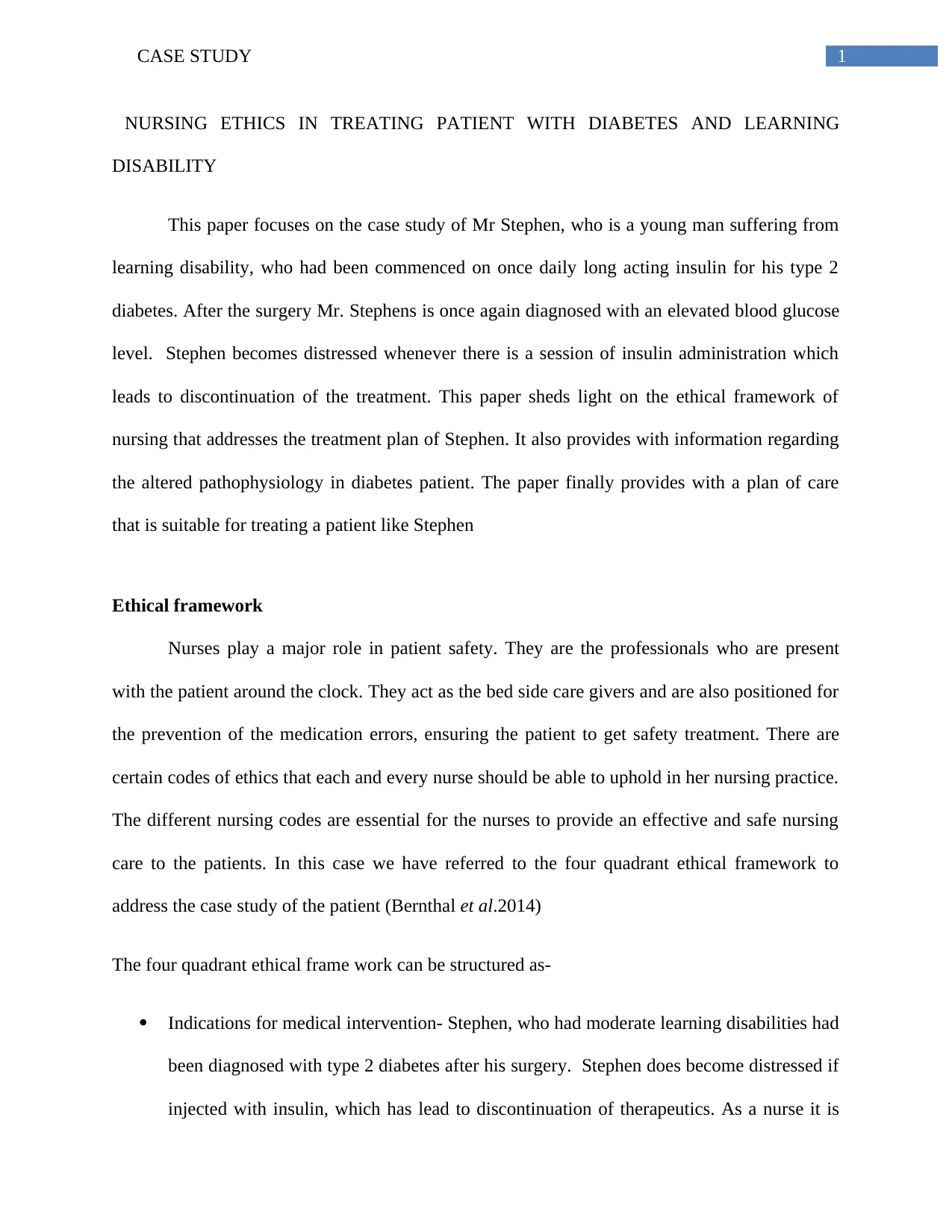
1CASE STUDY
NURSING ETHICS IN TREATING PATIENT WITH DIABETES AND LEARNING
DISABILITY
This paper focuses on the case study of Mr Stephen, who is a young man suffering from
learning disability, who had been commenced on once daily long acting insulin for his type 2
diabetes. After the surgery Mr. Stephens is once again diagnosed with an elevated blood glucose
level. Stephen becomes distressed whenever there is a session of insulin administration which
leads to discontinuation of the treatment. This paper sheds light on the ethical framework of
nursing that addresses the treatment plan of Stephen. It also provides with information regarding
the altered pathophysiology in diabetes patient. The paper finally provides with a plan of care
that is suitable for treating a patient like Stephen
Ethical framework
Nurses play a major role in patient safety. They are the professionals who are present
with the patient around the clock. They act as the bed side care givers and are also positioned for
the prevention of the medication errors, ensuring the patient to get safety treatment. There are
certain codes of ethics that each and every nurse should be able to uphold in her nursing practice.
The different nursing codes are essential for the nurses to provide an effective and safe nursing
care to the patients. In this case we have referred to the four quadrant ethical framework to
address the case study of the patient (Bernthal et al.2014)
The four quadrant ethical frame work can be structured as-
Indications for medical intervention- Stephen, who had moderate learning disabilities had
been diagnosed with type 2 diabetes after his surgery. Stephen does become distressed if
injected with insulin, which has lead to discontinuation of therapeutics. As a nurse it is
NURSING ETHICS IN TREATING PATIENT WITH DIABETES AND LEARNING
DISABILITY
This paper focuses on the case study of Mr Stephen, who is a young man suffering from
learning disability, who had been commenced on once daily long acting insulin for his type 2
diabetes. After the surgery Mr. Stephens is once again diagnosed with an elevated blood glucose
level. Stephen becomes distressed whenever there is a session of insulin administration which
leads to discontinuation of the treatment. This paper sheds light on the ethical framework of
nursing that addresses the treatment plan of Stephen. It also provides with information regarding
the altered pathophysiology in diabetes patient. The paper finally provides with a plan of care
that is suitable for treating a patient like Stephen
Ethical framework
Nurses play a major role in patient safety. They are the professionals who are present
with the patient around the clock. They act as the bed side care givers and are also positioned for
the prevention of the medication errors, ensuring the patient to get safety treatment. There are
certain codes of ethics that each and every nurse should be able to uphold in her nursing practice.
The different nursing codes are essential for the nurses to provide an effective and safe nursing
care to the patients. In this case we have referred to the four quadrant ethical framework to
address the case study of the patient (Bernthal et al.2014)
The four quadrant ethical frame work can be structured as-
Indications for medical intervention- Stephen, who had moderate learning disabilities had
been diagnosed with type 2 diabetes after his surgery. Stephen does become distressed if
injected with insulin, which has lead to discontinuation of therapeutics. As a nurse it is
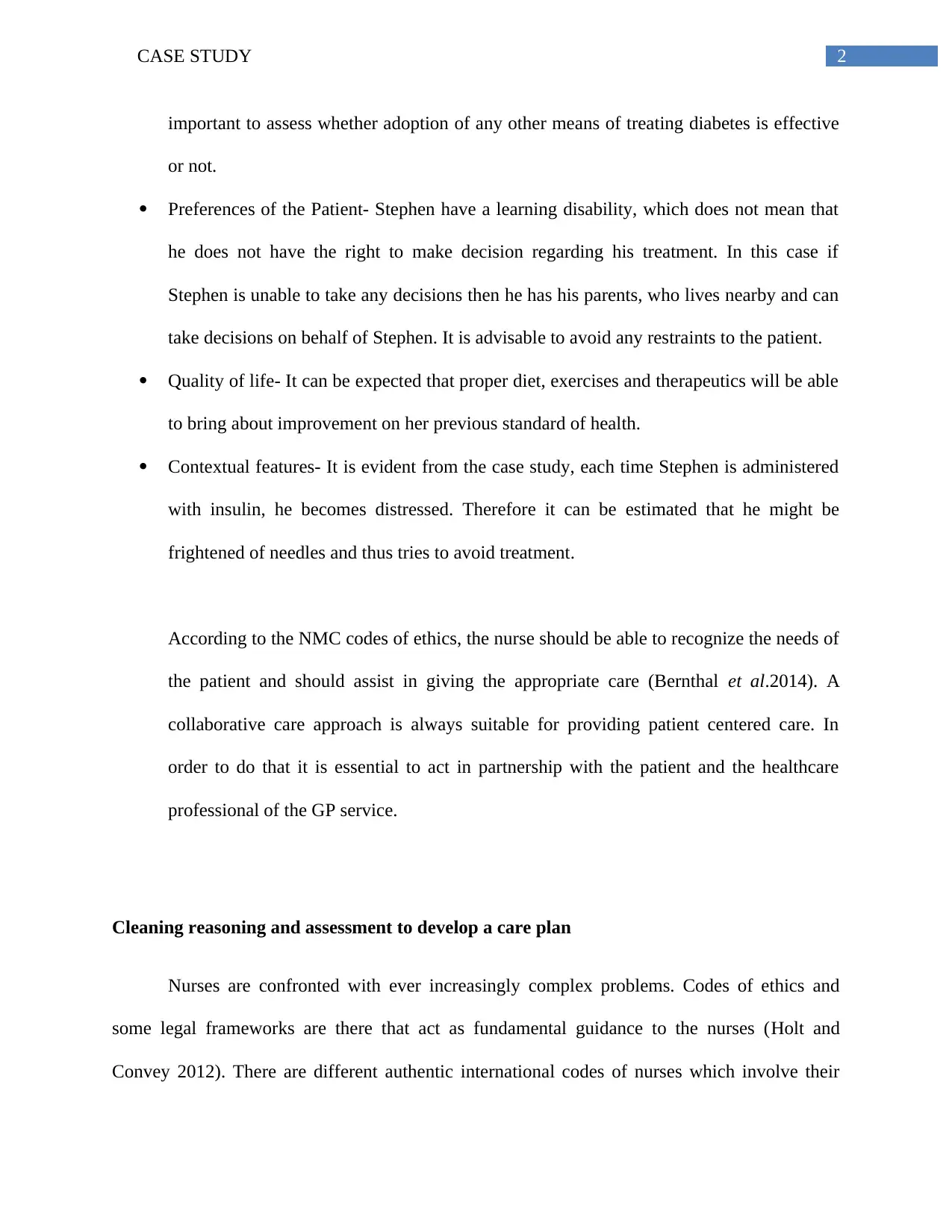
2CASE STUDY
important to assess whether adoption of any other means of treating diabetes is effective
or not.
Preferences of the Patient- Stephen have a learning disability, which does not mean that
he does not have the right to make decision regarding his treatment. In this case if
Stephen is unable to take any decisions then he has his parents, who lives nearby and can
take decisions on behalf of Stephen. It is advisable to avoid any restraints to the patient.
Quality of life- It can be expected that proper diet, exercises and therapeutics will be able
to bring about improvement on her previous standard of health.
Contextual features- It is evident from the case study, each time Stephen is administered
with insulin, he becomes distressed. Therefore it can be estimated that he might be
frightened of needles and thus tries to avoid treatment.
According to the NMC codes of ethics, the nurse should be able to recognize the needs of
the patient and should assist in giving the appropriate care (Bernthal et al.2014). A
collaborative care approach is always suitable for providing patient centered care. In
order to do that it is essential to act in partnership with the patient and the healthcare
professional of the GP service.
Cleaning reasoning and assessment to develop a care plan
Nurses are confronted with ever increasingly complex problems. Codes of ethics and
some legal frameworks are there that act as fundamental guidance to the nurses (Holt and
Convey 2012). There are different authentic international codes of nurses which involve their
important to assess whether adoption of any other means of treating diabetes is effective
or not.
Preferences of the Patient- Stephen have a learning disability, which does not mean that
he does not have the right to make decision regarding his treatment. In this case if
Stephen is unable to take any decisions then he has his parents, who lives nearby and can
take decisions on behalf of Stephen. It is advisable to avoid any restraints to the patient.
Quality of life- It can be expected that proper diet, exercises and therapeutics will be able
to bring about improvement on her previous standard of health.
Contextual features- It is evident from the case study, each time Stephen is administered
with insulin, he becomes distressed. Therefore it can be estimated that he might be
frightened of needles and thus tries to avoid treatment.
According to the NMC codes of ethics, the nurse should be able to recognize the needs of
the patient and should assist in giving the appropriate care (Bernthal et al.2014). A
collaborative care approach is always suitable for providing patient centered care. In
order to do that it is essential to act in partnership with the patient and the healthcare
professional of the GP service.
Cleaning reasoning and assessment to develop a care plan
Nurses are confronted with ever increasingly complex problems. Codes of ethics and
some legal frameworks are there that act as fundamental guidance to the nurses (Holt and
Convey 2012). There are different authentic international codes of nurses which involve their
⊘ This is a preview!⊘
Do you want full access?
Subscribe today to unlock all pages.

Trusted by 1+ million students worldwide
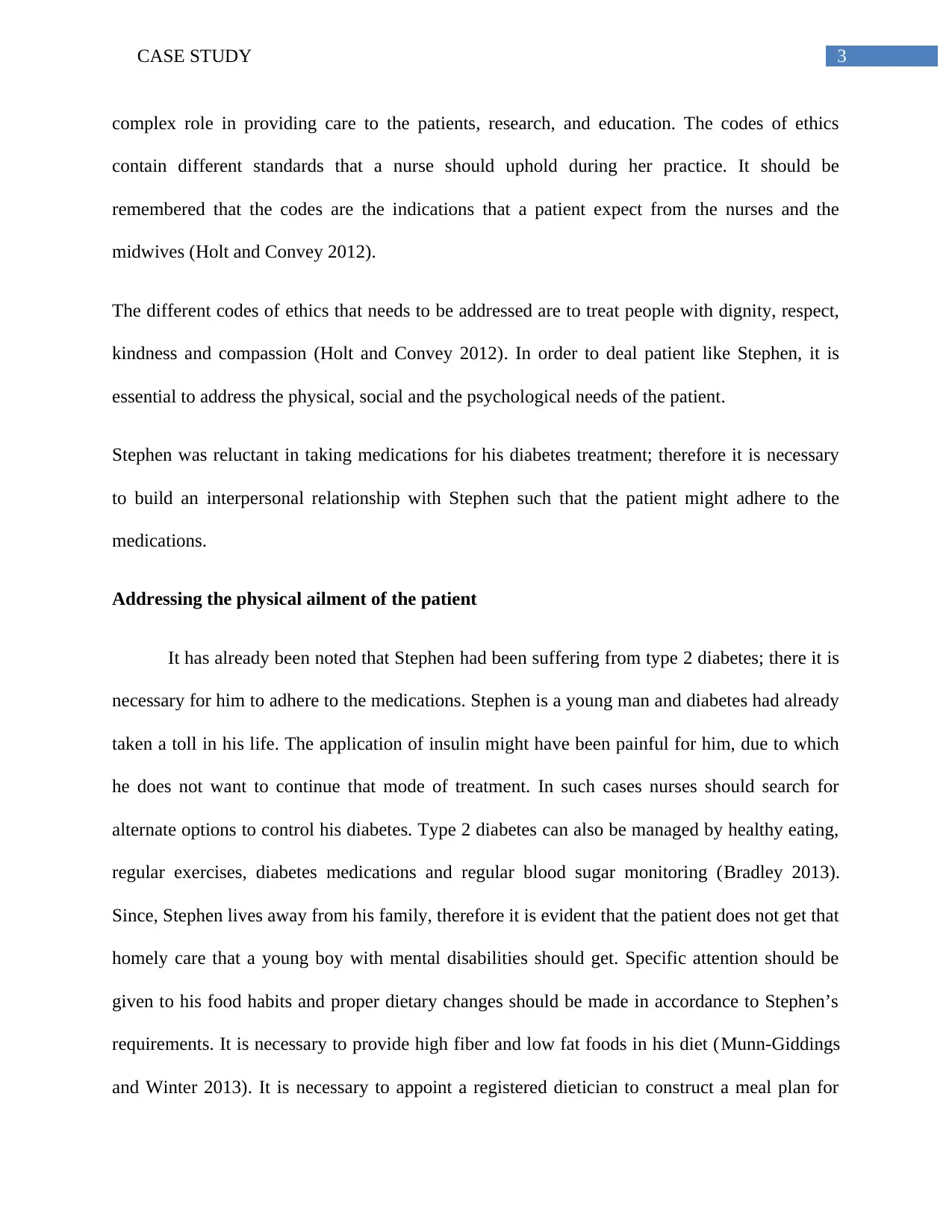
3CASE STUDY
complex role in providing care to the patients, research, and education. The codes of ethics
contain different standards that a nurse should uphold during her practice. It should be
remembered that the codes are the indications that a patient expect from the nurses and the
midwives (Holt and Convey 2012).
The different codes of ethics that needs to be addressed are to treat people with dignity, respect,
kindness and compassion (Holt and Convey 2012). In order to deal patient like Stephen, it is
essential to address the physical, social and the psychological needs of the patient.
Stephen was reluctant in taking medications for his diabetes treatment; therefore it is necessary
to build an interpersonal relationship with Stephen such that the patient might adhere to the
medications.
Addressing the physical ailment of the patient
It has already been noted that Stephen had been suffering from type 2 diabetes; there it is
necessary for him to adhere to the medications. Stephen is a young man and diabetes had already
taken a toll in his life. The application of insulin might have been painful for him, due to which
he does not want to continue that mode of treatment. In such cases nurses should search for
alternate options to control his diabetes. Type 2 diabetes can also be managed by healthy eating,
regular exercises, diabetes medications and regular blood sugar monitoring (Bradley 2013).
Since, Stephen lives away from his family, therefore it is evident that the patient does not get that
homely care that a young boy with mental disabilities should get. Specific attention should be
given to his food habits and proper dietary changes should be made in accordance to Stephen’s
requirements. It is necessary to provide high fiber and low fat foods in his diet (Munn-Giddings
and Winter 2013). It is necessary to appoint a registered dietician to construct a meal plan for
complex role in providing care to the patients, research, and education. The codes of ethics
contain different standards that a nurse should uphold during her practice. It should be
remembered that the codes are the indications that a patient expect from the nurses and the
midwives (Holt and Convey 2012).
The different codes of ethics that needs to be addressed are to treat people with dignity, respect,
kindness and compassion (Holt and Convey 2012). In order to deal patient like Stephen, it is
essential to address the physical, social and the psychological needs of the patient.
Stephen was reluctant in taking medications for his diabetes treatment; therefore it is necessary
to build an interpersonal relationship with Stephen such that the patient might adhere to the
medications.
Addressing the physical ailment of the patient
It has already been noted that Stephen had been suffering from type 2 diabetes; there it is
necessary for him to adhere to the medications. Stephen is a young man and diabetes had already
taken a toll in his life. The application of insulin might have been painful for him, due to which
he does not want to continue that mode of treatment. In such cases nurses should search for
alternate options to control his diabetes. Type 2 diabetes can also be managed by healthy eating,
regular exercises, diabetes medications and regular blood sugar monitoring (Bradley 2013).
Since, Stephen lives away from his family, therefore it is evident that the patient does not get that
homely care that a young boy with mental disabilities should get. Specific attention should be
given to his food habits and proper dietary changes should be made in accordance to Stephen’s
requirements. It is necessary to provide high fiber and low fat foods in his diet (Munn-Giddings
and Winter 2013). It is necessary to appoint a registered dietician to construct a meal plan for
Paraphrase This Document
Need a fresh take? Get an instant paraphrase of this document with our AI Paraphraser
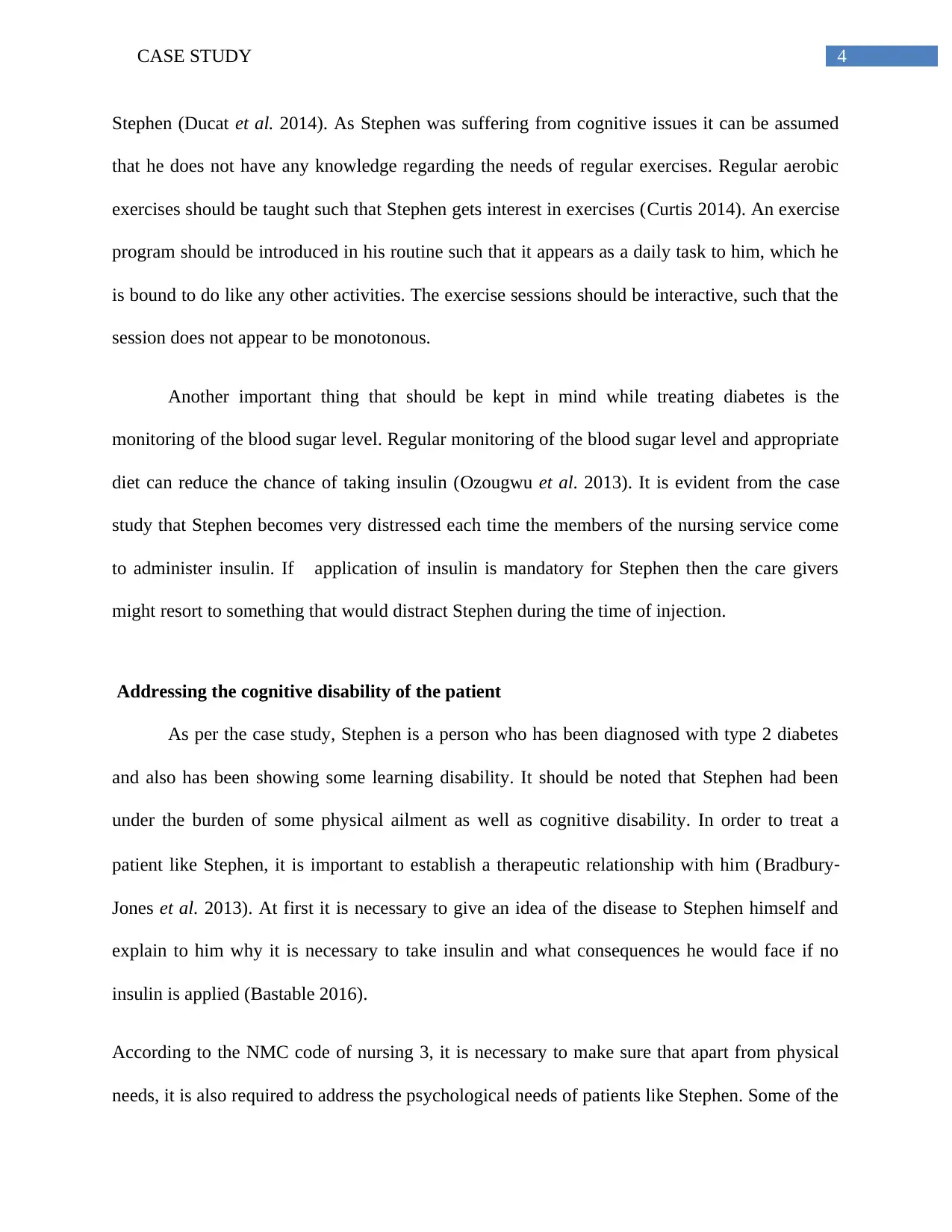
4CASE STUDY
Stephen (Ducat et al. 2014). As Stephen was suffering from cognitive issues it can be assumed
that he does not have any knowledge regarding the needs of regular exercises. Regular aerobic
exercises should be taught such that Stephen gets interest in exercises (Curtis 2014). An exercise
program should be introduced in his routine such that it appears as a daily task to him, which he
is bound to do like any other activities. The exercise sessions should be interactive, such that the
session does not appear to be monotonous.
Another important thing that should be kept in mind while treating diabetes is the
monitoring of the blood sugar level. Regular monitoring of the blood sugar level and appropriate
diet can reduce the chance of taking insulin (Ozougwu et al. 2013). It is evident from the case
study that Stephen becomes very distressed each time the members of the nursing service come
to administer insulin. If application of insulin is mandatory for Stephen then the care givers
might resort to something that would distract Stephen during the time of injection.
Addressing the cognitive disability of the patient
As per the case study, Stephen is a person who has been diagnosed with type 2 diabetes
and also has been showing some learning disability. It should be noted that Stephen had been
under the burden of some physical ailment as well as cognitive disability. In order to treat a
patient like Stephen, it is important to establish a therapeutic relationship with him (Bradbury‐
Jones et al. 2013). At first it is necessary to give an idea of the disease to Stephen himself and
explain to him why it is necessary to take insulin and what consequences he would face if no
insulin is applied (Bastable 2016).
According to the NMC code of nursing 3, it is necessary to make sure that apart from physical
needs, it is also required to address the psychological needs of patients like Stephen. Some of the
Stephen (Ducat et al. 2014). As Stephen was suffering from cognitive issues it can be assumed
that he does not have any knowledge regarding the needs of regular exercises. Regular aerobic
exercises should be taught such that Stephen gets interest in exercises (Curtis 2014). An exercise
program should be introduced in his routine such that it appears as a daily task to him, which he
is bound to do like any other activities. The exercise sessions should be interactive, such that the
session does not appear to be monotonous.
Another important thing that should be kept in mind while treating diabetes is the
monitoring of the blood sugar level. Regular monitoring of the blood sugar level and appropriate
diet can reduce the chance of taking insulin (Ozougwu et al. 2013). It is evident from the case
study that Stephen becomes very distressed each time the members of the nursing service come
to administer insulin. If application of insulin is mandatory for Stephen then the care givers
might resort to something that would distract Stephen during the time of injection.
Addressing the cognitive disability of the patient
As per the case study, Stephen is a person who has been diagnosed with type 2 diabetes
and also has been showing some learning disability. It should be noted that Stephen had been
under the burden of some physical ailment as well as cognitive disability. In order to treat a
patient like Stephen, it is important to establish a therapeutic relationship with him (Bradbury‐
Jones et al. 2013). At first it is necessary to give an idea of the disease to Stephen himself and
explain to him why it is necessary to take insulin and what consequences he would face if no
insulin is applied (Bastable 2016).
According to the NMC code of nursing 3, it is necessary to make sure that apart from physical
needs, it is also required to address the psychological needs of patients like Stephen. Some of the
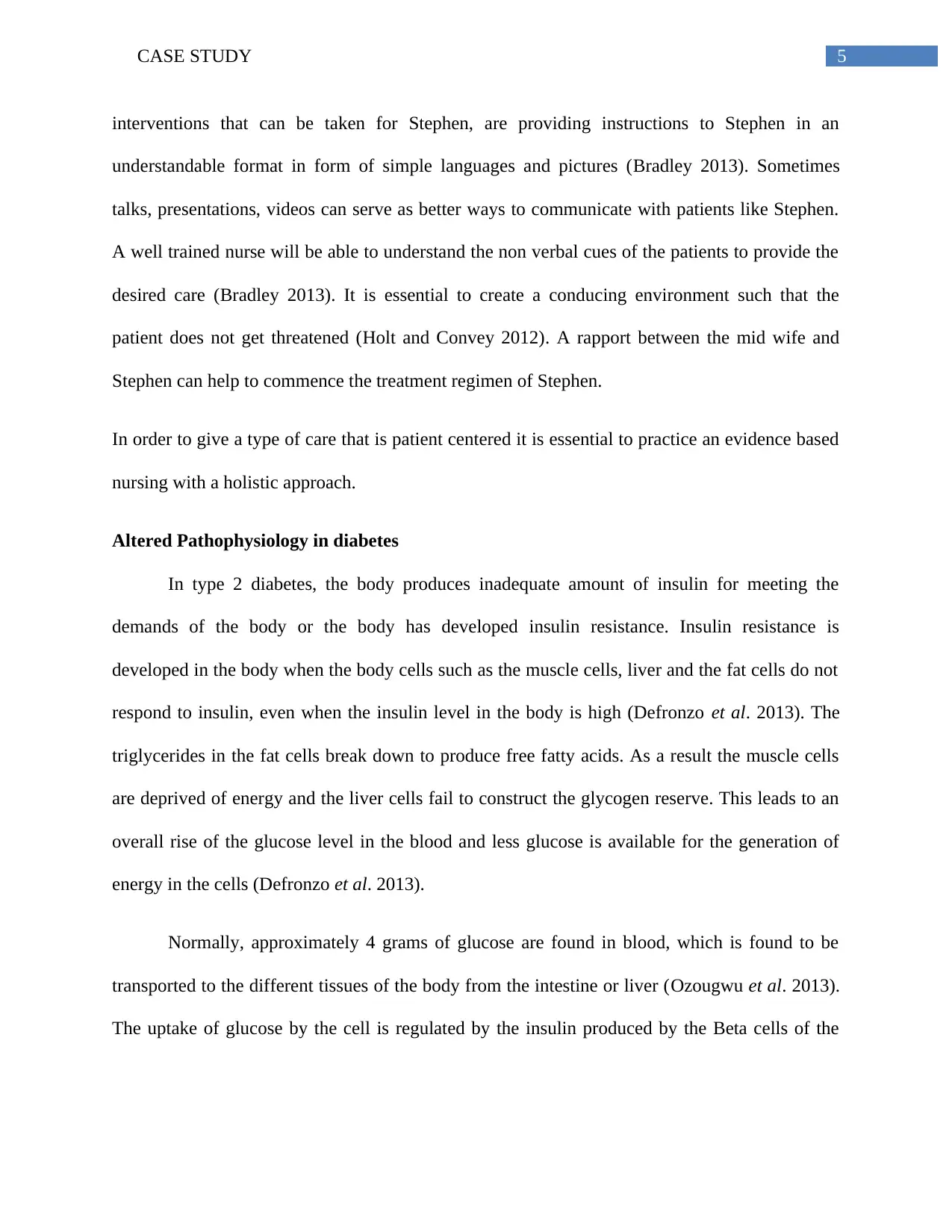
5CASE STUDY
interventions that can be taken for Stephen, are providing instructions to Stephen in an
understandable format in form of simple languages and pictures (Bradley 2013). Sometimes
talks, presentations, videos can serve as better ways to communicate with patients like Stephen.
A well trained nurse will be able to understand the non verbal cues of the patients to provide the
desired care (Bradley 2013). It is essential to create a conducing environment such that the
patient does not get threatened (Holt and Convey 2012). A rapport between the mid wife and
Stephen can help to commence the treatment regimen of Stephen.
In order to give a type of care that is patient centered it is essential to practice an evidence based
nursing with a holistic approach.
Altered Pathophysiology in diabetes
In type 2 diabetes, the body produces inadequate amount of insulin for meeting the
demands of the body or the body has developed insulin resistance. Insulin resistance is
developed in the body when the body cells such as the muscle cells, liver and the fat cells do not
respond to insulin, even when the insulin level in the body is high (Defronzo et al. 2013). The
triglycerides in the fat cells break down to produce free fatty acids. As a result the muscle cells
are deprived of energy and the liver cells fail to construct the glycogen reserve. This leads to an
overall rise of the glucose level in the blood and less glucose is available for the generation of
energy in the cells (Defronzo et al. 2013).
Normally, approximately 4 grams of glucose are found in blood, which is found to be
transported to the different tissues of the body from the intestine or liver (Ozougwu et al. 2013).
The uptake of glucose by the cell is regulated by the insulin produced by the Beta cells of the
interventions that can be taken for Stephen, are providing instructions to Stephen in an
understandable format in form of simple languages and pictures (Bradley 2013). Sometimes
talks, presentations, videos can serve as better ways to communicate with patients like Stephen.
A well trained nurse will be able to understand the non verbal cues of the patients to provide the
desired care (Bradley 2013). It is essential to create a conducing environment such that the
patient does not get threatened (Holt and Convey 2012). A rapport between the mid wife and
Stephen can help to commence the treatment regimen of Stephen.
In order to give a type of care that is patient centered it is essential to practice an evidence based
nursing with a holistic approach.
Altered Pathophysiology in diabetes
In type 2 diabetes, the body produces inadequate amount of insulin for meeting the
demands of the body or the body has developed insulin resistance. Insulin resistance is
developed in the body when the body cells such as the muscle cells, liver and the fat cells do not
respond to insulin, even when the insulin level in the body is high (Defronzo et al. 2013). The
triglycerides in the fat cells break down to produce free fatty acids. As a result the muscle cells
are deprived of energy and the liver cells fail to construct the glycogen reserve. This leads to an
overall rise of the glucose level in the blood and less glucose is available for the generation of
energy in the cells (Defronzo et al. 2013).
Normally, approximately 4 grams of glucose are found in blood, which is found to be
transported to the different tissues of the body from the intestine or liver (Ozougwu et al. 2013).
The uptake of glucose by the cell is regulated by the insulin produced by the Beta cells of the
⊘ This is a preview!⊘
Do you want full access?
Subscribe today to unlock all pages.

Trusted by 1+ million students worldwide
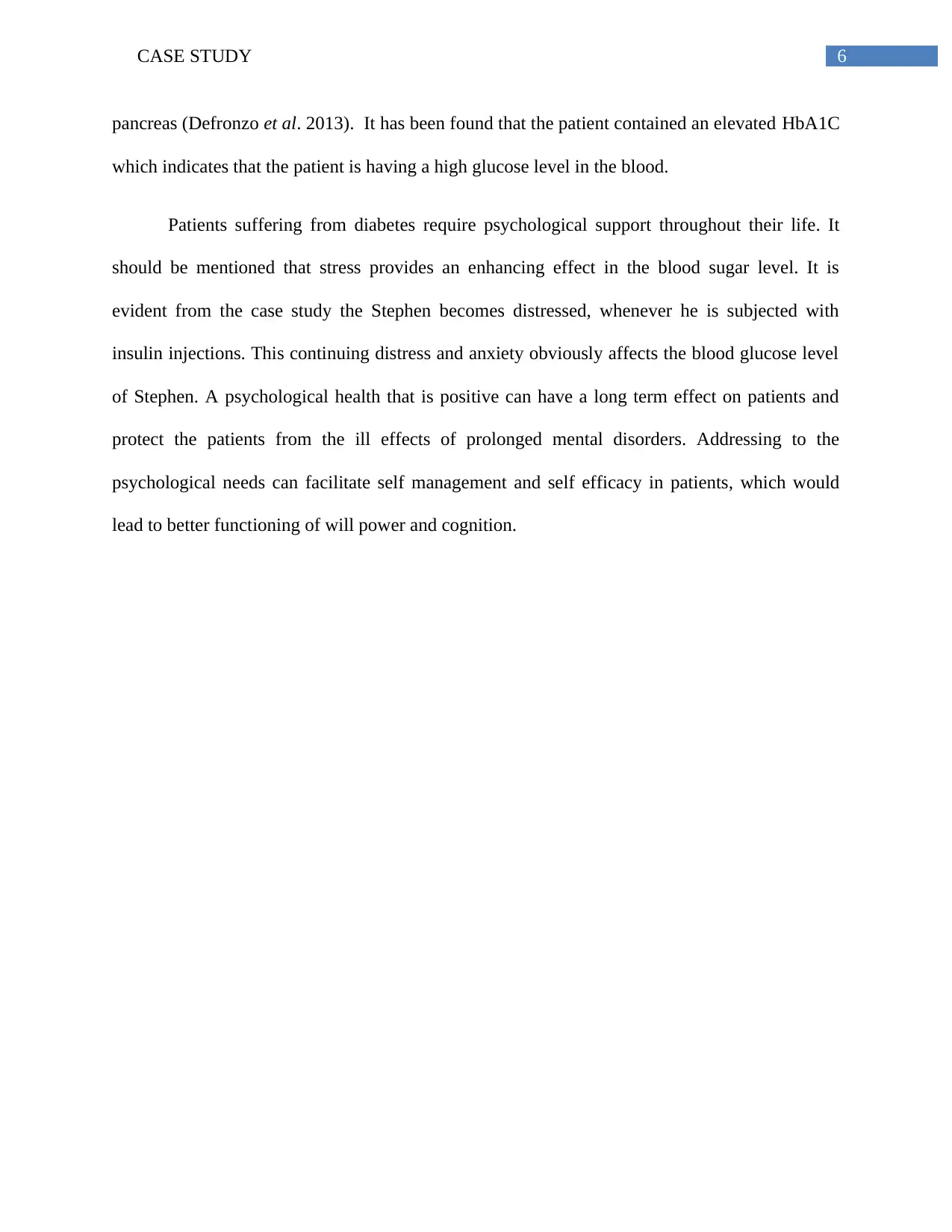
6CASE STUDY
pancreas (Defronzo et al. 2013). It has been found that the patient contained an elevated HbA1C
which indicates that the patient is having a high glucose level in the blood.
Patients suffering from diabetes require psychological support throughout their life. It
should be mentioned that stress provides an enhancing effect in the blood sugar level. It is
evident from the case study the Stephen becomes distressed, whenever he is subjected with
insulin injections. This continuing distress and anxiety obviously affects the blood glucose level
of Stephen. A psychological health that is positive can have a long term effect on patients and
protect the patients from the ill effects of prolonged mental disorders. Addressing to the
psychological needs can facilitate self management and self efficacy in patients, which would
lead to better functioning of will power and cognition.
pancreas (Defronzo et al. 2013). It has been found that the patient contained an elevated HbA1C
which indicates that the patient is having a high glucose level in the blood.
Patients suffering from diabetes require psychological support throughout their life. It
should be mentioned that stress provides an enhancing effect in the blood sugar level. It is
evident from the case study the Stephen becomes distressed, whenever he is subjected with
insulin injections. This continuing distress and anxiety obviously affects the blood glucose level
of Stephen. A psychological health that is positive can have a long term effect on patients and
protect the patients from the ill effects of prolonged mental disorders. Addressing to the
psychological needs can facilitate self management and self efficacy in patients, which would
lead to better functioning of will power and cognition.
Paraphrase This Document
Need a fresh take? Get an instant paraphrase of this document with our AI Paraphraser
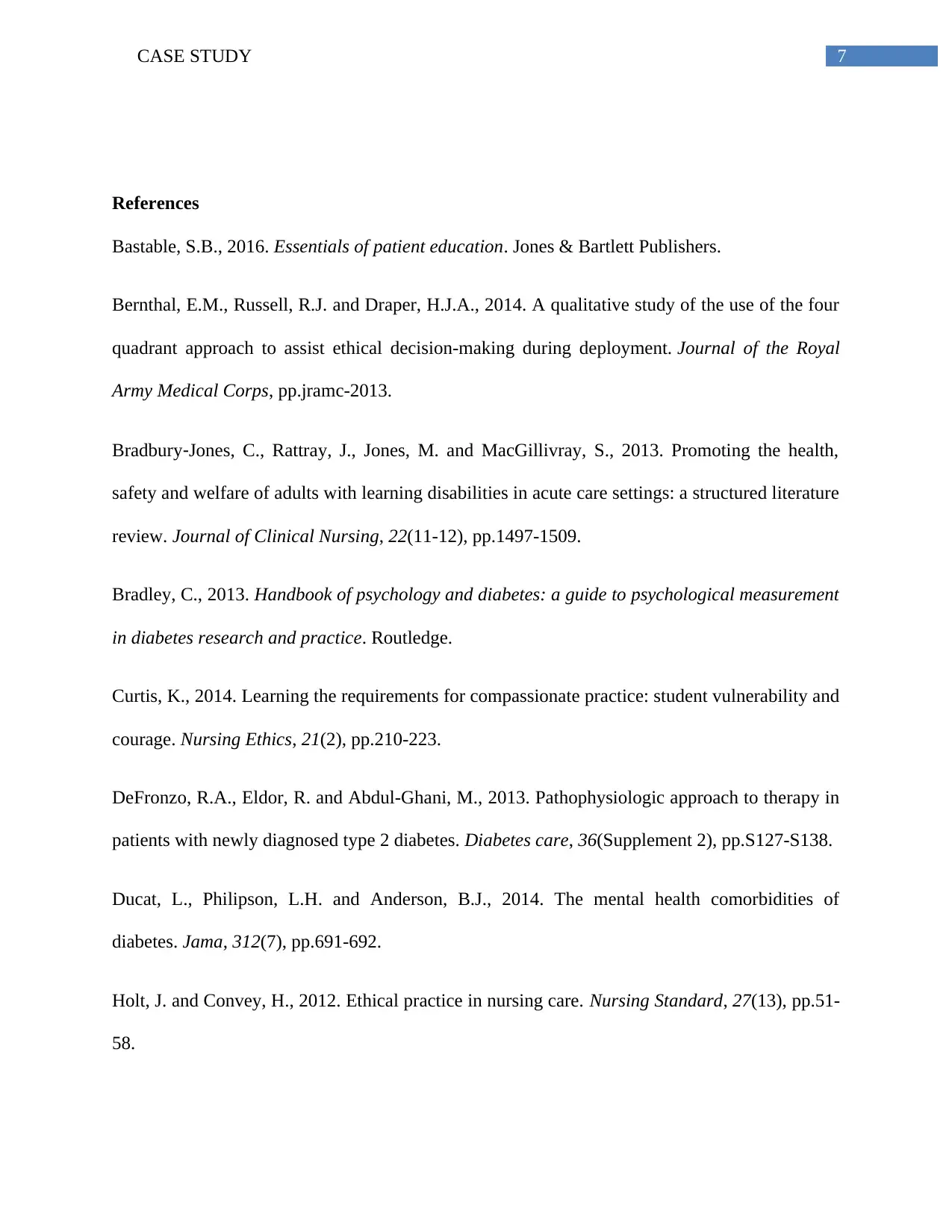
7CASE STUDY
References
Bastable, S.B., 2016. Essentials of patient education. Jones & Bartlett Publishers.
Bernthal, E.M., Russell, R.J. and Draper, H.J.A., 2014. A qualitative study of the use of the four
quadrant approach to assist ethical decision-making during deployment. Journal of the Royal
Army Medical Corps, pp.jramc-2013.
Bradbury‐Jones, C., Rattray, J., Jones, M. and MacGillivray, S., 2013. Promoting the health,
safety and welfare of adults with learning disabilities in acute care settings: a structured literature
review. Journal of Clinical Nursing, 22(11-12), pp.1497-1509.
Bradley, C., 2013. Handbook of psychology and diabetes: a guide to psychological measurement
in diabetes research and practice. Routledge.
Curtis, K., 2014. Learning the requirements for compassionate practice: student vulnerability and
courage. Nursing Ethics, 21(2), pp.210-223.
DeFronzo, R.A., Eldor, R. and Abdul-Ghani, M., 2013. Pathophysiologic approach to therapy in
patients with newly diagnosed type 2 diabetes. Diabetes care, 36(Supplement 2), pp.S127-S138.
Ducat, L., Philipson, L.H. and Anderson, B.J., 2014. The mental health comorbidities of
diabetes. Jama, 312(7), pp.691-692.
Holt, J. and Convey, H., 2012. Ethical practice in nursing care. Nursing Standard, 27(13), pp.51-
58.
References
Bastable, S.B., 2016. Essentials of patient education. Jones & Bartlett Publishers.
Bernthal, E.M., Russell, R.J. and Draper, H.J.A., 2014. A qualitative study of the use of the four
quadrant approach to assist ethical decision-making during deployment. Journal of the Royal
Army Medical Corps, pp.jramc-2013.
Bradbury‐Jones, C., Rattray, J., Jones, M. and MacGillivray, S., 2013. Promoting the health,
safety and welfare of adults with learning disabilities in acute care settings: a structured literature
review. Journal of Clinical Nursing, 22(11-12), pp.1497-1509.
Bradley, C., 2013. Handbook of psychology and diabetes: a guide to psychological measurement
in diabetes research and practice. Routledge.
Curtis, K., 2014. Learning the requirements for compassionate practice: student vulnerability and
courage. Nursing Ethics, 21(2), pp.210-223.
DeFronzo, R.A., Eldor, R. and Abdul-Ghani, M., 2013. Pathophysiologic approach to therapy in
patients with newly diagnosed type 2 diabetes. Diabetes care, 36(Supplement 2), pp.S127-S138.
Ducat, L., Philipson, L.H. and Anderson, B.J., 2014. The mental health comorbidities of
diabetes. Jama, 312(7), pp.691-692.
Holt, J. and Convey, H., 2012. Ethical practice in nursing care. Nursing Standard, 27(13), pp.51-
58.
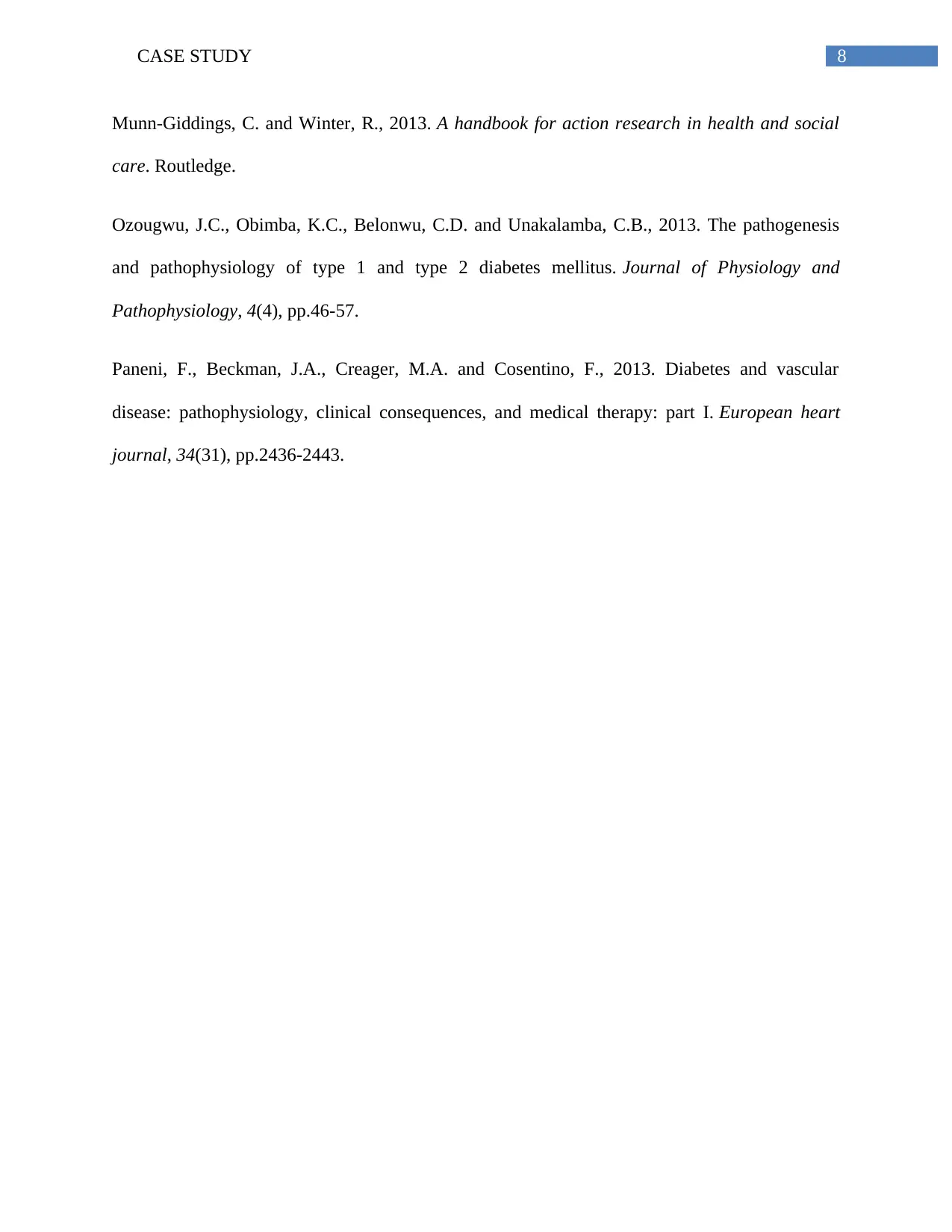
8CASE STUDY
Munn-Giddings, C. and Winter, R., 2013. A handbook for action research in health and social
care. Routledge.
Ozougwu, J.C., Obimba, K.C., Belonwu, C.D. and Unakalamba, C.B., 2013. The pathogenesis
and pathophysiology of type 1 and type 2 diabetes mellitus. Journal of Physiology and
Pathophysiology, 4(4), pp.46-57.
Paneni, F., Beckman, J.A., Creager, M.A. and Cosentino, F., 2013. Diabetes and vascular
disease: pathophysiology, clinical consequences, and medical therapy: part I. European heart
journal, 34(31), pp.2436-2443.
Munn-Giddings, C. and Winter, R., 2013. A handbook for action research in health and social
care. Routledge.
Ozougwu, J.C., Obimba, K.C., Belonwu, C.D. and Unakalamba, C.B., 2013. The pathogenesis
and pathophysiology of type 1 and type 2 diabetes mellitus. Journal of Physiology and
Pathophysiology, 4(4), pp.46-57.
Paneni, F., Beckman, J.A., Creager, M.A. and Cosentino, F., 2013. Diabetes and vascular
disease: pathophysiology, clinical consequences, and medical therapy: part I. European heart
journal, 34(31), pp.2436-2443.
⊘ This is a preview!⊘
Do you want full access?
Subscribe today to unlock all pages.

Trusted by 1+ million students worldwide
1 out of 9
Related Documents
Your All-in-One AI-Powered Toolkit for Academic Success.
+13062052269
info@desklib.com
Available 24*7 on WhatsApp / Email
![[object Object]](/_next/static/media/star-bottom.7253800d.svg)
Unlock your academic potential
Copyright © 2020–2025 A2Z Services. All Rights Reserved. Developed and managed by ZUCOL.





